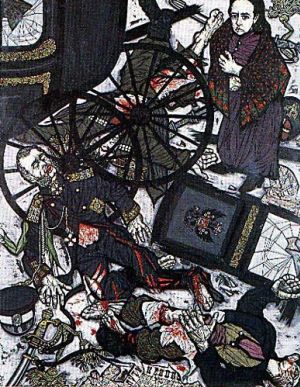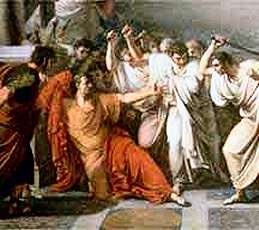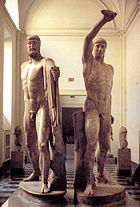(Via Jessica @ feministing 2008-02-20.)
There is some welcome news from Mississippi, where one of the worst child prisons in the United States is going to be shuttered by order of the governor and the state Department of Human Services. (The prison, named Columbia Training School
in honor of George Orwell, would be better described as a paramilitary torture camp for children ages 10-18.) The decision comes in the wake of a federal investigation that uncovered prison guards, drill instructors, recreation
officers, and counselors
using hog-tying, pole-shackling, pepper-spraying, cruel and bizarre punitive exercises,
punching, slapping, choking, and isolation cells in which children were stripped naked and left alone in the dark for hours or even days on end. At least four separate federal lawsuits have been filed against Mississippi child prisons in the past four years over the treatment of the children imprisoned there, including the severe beating of a 14 year old boy and the repeated rape of a 14 year old girl by prison guards. Here is some of what went on at Columbia:
The majority of youth committed to Oakley and Columbia are nonviolent offenders. For example, 75 percent of the girls at
Columbia are committed for status offenses, probation violations, or contempt of court. The majority of boys at Oakley are
committed for property offenses, lower level drug possession charges, or auto theft charges.
… Approximately 10 to 15 boys and girls consistently described [hog-tying of children at Columbia], where youth are
placed face down on the floor with their hands and feet shackled and drawn together. That is, youths' hands are handcuffed behind
their backs. Their feet are shackled together and then belts or metal chains are wrapped around the two sets of restraints, pulling
them together. A 13-year-old boy, in the SIU [Special Intervention Unit] on suicide watch, told us that he had been hog-tied twice
while in the SIU. Another boy told us that he was hog-tied for refusing to follow orders. Several girls in Hammond Cottage told us
that either they had been hog-tied or they had witnessed other girls being hog-tied. They reported that girls are typically tied for
three hour periods in the corners of the cottage and stated that girls were also hog-tied in the SIU. Girls also reported being
hogtied in a SIU cell called the dark room.
Contrary to Columbia's policy that requires the documenting of all uses of restraints, the practice is not documented in
incident reports or unit logbooks. When our expert consultant discussed the apparent discrepancy between youth reports and lack
of incident report documentation, Columbia SIU staff either denied that these incidents took place or reluctantly admitted
they may have occurred — but not during their shifts. A senior manager claimed it had been a long time since hog-tying had
occurred because the practice was inhumane.
However, one relatively new SIU staff person stated that hog-tying had
occurred in the boys' SIU a few months prior to our visit.
… Youth reported that they had either observed or experienced having their arms and legs shackled to poles in
public places. For instance, one young girl reported that her arms and legs were handcuffed and shackled around a utility pole
because she was non-compliant during military exercises. The rest of the unit was forced to perform military drills around
her. The youth was shackled for at least three hours, released for lunch, and briefly shackled again. … Another girl reported that
two weeks prior to our visit, she was shackled to a pole for talking in the cafeteria. Still another girl reported that she was
shackled to a pole for approximately four hours because she did not say, Yes, sir,
on command. Again, this practice is not
documented in incident reports or unit logbooks in violation of Columbia's restraint policy. …
Girls in the SIU at Columbia are punished for acting out or for being suicidal by being placed in a cell called the dark
room.
The dark room
is a locked, windowless isolation cell with lighting controlled by staff. When the lights are turned
out, as the girls reported they are when the room is in use, the room is completely dark. The room is stripped of everything but
a drain in the floor which serves as a toilet. Most girls are stripped naked when placed in the dark room.
According to
Columbia staff, the reason girls must remove their clothing before being placed in the darkroom, is that there is metal grating on the
ceiling and the cell door which could be used for hanging attempts by suicidal girls. Such suicidal hazards should be remedied rather
than requiring suicidal children to strip naked.
One girl told us that the weekend prior to our visit, she was placed naked in the dark room
from Friday until Monday
morning. She stated that she was allowed out of the cell once a day to take a shower, but received all her meals inside of the
cell. Another girl told us that in July 2002, she was placed in the dark room
with the lights off for three days with little
access to water as her requests for water were largely ignored.
… During our visit to the girls' SIU at Columbia, there were 14 girls present. Nine of the girls had been locked in bare
cells for more than a week; one girl had been locked in a bare cell for 114 days. The conditions we observed in the SIU are
particularly inhumane. The cells are extremely hot with inadequate ventilation. Some girls are naked in a dark room
where they must urinate and defecate in a hole that they cannot flush. Restraint chairs are use for punishment in violation of
Columbia's own policy and procedures manual. OC [pepper] spray is sometimes used in response to a youth's minor misbehavior. As
discussed earlier, sometimes, girls are hog-tied. Girls are often not given access to basic necessities, such as water, personal
hygiene items, and bathroom facilities, and girls are not given sufficient mental health services. …
[Y]outh report sitting in a chair,
in which youth are required to assume a sitting position while holding their backs up
against the wall with knees bent for as long as 20 to 30 minutes. Youth also are forced to perform guard duty.
Youth are
awakened in the middle of the night, required to get dressed, and walk inside the cottage for hours with their hands to their heads
(similar to a military salute) from bed to bed. … Boys housed in the cottages are sent by drill instructors to the SIU during the day
for punishment for failing to perform exercises. SIU staff confirmed that boys' punishment may last for hours and consists of running
around tables in the SIU day room with mattresses on their backs. Girls are punished in the military field by being forced to run with
automobile tires around their bodies or carrying logs. Girls reported being forced to eat their own vomit if they throw-up while
exercising in the hot sun.
… In the girls' SIU at Columbia, staff reportedly have hit, choked, and slapped girls. For instance, girls reported that a
ten-year-old girl was slapped by a male security guard. A young boy in the boys' SIU reported that before being taken to the SIU,
security slapped him twice in the face and placed his neck in a sleeper hold.
… According to the facilities' policy, OC [pepper] spray may be used in only three situations: to quell a riot
; or to
prevent further injury when students are fighting
and all other efforts to resolve the fight have failed; or if a youth
possesses a device clearly intended to be used as a weapon and refuses to disarm.
… At Columbia, boys in the SIU
reported that staff sprayed under their locked cell doors and that staff sprayed boys in the face while they were hog-tied. Boys also
told us that staff sprayed into the air while boys were doing exercises for punishment in the SIU. Incident reports make clear that
suicidal youth are sprayed for their suicidal gestures and behaviors and that youth locked in isolation rooms who bang on the door
of their cell are sprayed. A log entry for the SIU in May 2002 indicates that a suicidal girl was sprayed because she refused to
remove her clothes before being placed in the dark room.
Youth at Columbia reported that staff routinely sprayed youth for failing to perform military exercises. … For example, a 13-year-old
boy was sprayed because he did not perform exercises. Reportedly, he was punished further by being forced to do 100 squat
thrusts, 100 push ups, and 100 jumping jacks. One girl, prior to being sent to the SIU, had difficulty keeping up with the group
during exercise in the parade field. She yelled to a staff person that it was hot and to shut up talking to me.
Security was
called and she was sprayed in the face. Youth also talked extensively about running the ridge,
a form of intensive running
on the campus grounds. Youth who refuse to run the ridge are reportedly sprayed by staff.
… Moreover, during our tour of Columbia, children made various abuse allegations concerning specific staff. Several girls alleged
that a recreation staff person forced girls to run and perform military exercises wearing tires. Many youth reported that the acting
head nurse routinely denied medical care and access to appropriate health services. The girls in the advanced cottage alleged that
a security guard engaged in inappropriate sexual behavior by standing in front of the uncovered windows of the girls' cottage and
observing them while they were undressing before going to bed.
… Activity, positive relationships between staff and youth, individual attention, school, exercise, reading, and counseling are
necessary aspects of an adequate adolescent suicide prevention program. Instead, at Columbia, suicidal youth are isolated in SIUs
in stripped cells, sometimes naked, are not allowed outdoor exercise, and receive very little schooling or counseling. As previously
discussed, some suicidal girls at Columbia are placed in the dark room.
Furthermore, in the isolation units or SIUs at both
facilities, children's mattresses are taken away during the day, leaving them with the option of lying or sitting on concrete or
standing. … In the evenings, youth are required to sit in silence for large blocks of time while they sort their clothes, clean their
boots, or for girls, braid each other's hair. … [Y]outh are forced to perform physical exercise and threatened with SIU if they are
caught talking to each other. In fact, youth expressed frustration at the wasted time and lack of rehabilitation services being offered
in the evenings. Lack of activity, social interaction, and counseling assistance put youth at risk for depression.
… The disciplinary practices [in paramilitary programs] are particularly harmful to the younger boys at Columbia who are
physically, emotionally, or psychologically unable to participate fully in the training program. Young boys at Columbia are not
developmentally suited to benefit from the military approach. Many staff perceived that this particular population was
noncompliant and anti-authority, when in reality, many of the boys are merely active third, fourth and fifth graders with short
attention spans. The result is that the younger boys stay at Columbia longer because they are considered behavior problems. …
Columbia's paramilitary program also is unsuitable for some of the troubled girls it serves. … Harsh disciplinary practices are
characterized as training. A June 2002 log book entry shows that a facility manager punished a girl by requiring her to sleep one
hour and walk one hour for two successive nights. This same girl also had to eat every meal standing for one week thereafter.
These punishments are largely unregulated and in some cases endorsed by supervisory personnel because they are considered
military training. …
A paramilitary program also is inappropriate for youth with learning or developmental disabilities. … For example, staff made
fun of a girl who had both physical and cognitive impairments. This girl was just learning to read and was unable to earn a
grade higher than 70 on the military test the youth must pass in order to move from the basic to the advanced phase of the
program. Her peers were concerned that she would never be able to pass the test. …
… Even asthmatic youth do not receive follow-up care to ensure that their cases are being managed. For example, a
girl was admitted to Columbia with a history of asthma. She was not asked about her medical history during her initial exam.
She subsequently told the nurse about her inhaler and that it prevented asthma attacks if used prior to exercise. The youth
never received an inhaler. While performing exercises, she began to have an asthma attack. She was not allowed to see the nurse
and was told to continue to exercise or be punished for disobedience.
… At Columbia, youth are required to attend religious services at the church every Sunday. Some girls reported they would be
subject to discipline if they did not sing during services. The facility administrator stated that youth had the option of not
attending the Sunday worship services if they chose not to, but both boys and girls indicated that attending Sunday worship
services was a requirement or they would be disciplined. Youth also must participate in a religious service in their cottages
every Tuesday evening or face discipline. The only reading material the children in the SIUs and some of the housing units
are allowed to possess is the Bible. We witnessed a mandatory group counseling session in the boys' SIU in which youth were
required to read Bible verses and sing religious songs.
In each of these cases, youth were required to engage in specific religious activities and were subject to disciplinary action if they
did not participate.
It is tempting to call this kind of treatment barbaric.
But that would be a slander against the good name of barbarians. The most brutal Hun or Vandal would never imagine inflicting this kind of relentless, sustained, coordinated, institutionalized sadism on anyone. They might kill you, but they wouldn’t pay professionals to break you. What would be the point? No, it takes a civilized society for people to imagine a use for a torture camp like Columbia–whether that’s institutionalizing their own revenge fantasies, or, what’s worse, claiming that it’s all for their victims’ own good.
Shuttering Columbia is a welcome move in the right direction. I hope that it will be followed by more, because more are certainly needed. Unfortunately, the governor is spinning this partly as a matter of inadequate staffing
and efficiency
in government spending. (As if what Columbia needed were even more hired thugs to run it efficiently.
They were the ones who created that hellhole in the first place.) The children imprisoned at Columbia, most of whom are nonviolent offenders who should never have been locked in government cages to begin with, are largely being shipped over to Oakley Training School, which previously had been the state’s child prison for older boys. Meanwhile, the All of Columbia’s 109 staff members will keep their jobs for now,
within the Mississippi state prison system–although apparently they will generally not be transferred over to the Oakley child prison, and this may be a way to defer firings until a later round of downsizing,
in order to mollify the prison guards’ union. But the take-away here is that as usual, when the government’s goon squad goes around humiliating, beating, raping, and torturing, even when their victims are ten year old or fourteen year old children, they can do so with almost complete impunity; politicians and their colleagues can be counted on to deny or minimize the problem, change the subject, and, if their hand is ever finally forced by external pressure, simultaneously personalize the problem as Yet Another Isolated Incident caused by A Few More Bad Apples — thus marginalizing any critique that takes the problem seriously enough to call the institutional culture and incentives of prison guards into question — while also stonewalling any efforts holding individual perpetrators personally accountable, either civilly or criminally, and instead pass off public-relations moves and minimal administrative reprimands as close enough for government work. This double strategy of personalizing blame while depersonalizing accountability ends up guaranteeing that the vast majority of people who create and run a torture camp like Columbia are allowed to operate in an environment of almost absolute impunity, and one or two of the most obviously atrocious prisons are very publicly closed, while the very people who made it that way are allowed to metastasize throughout the rest of the prison system.
So let’s celebrate the end of Columbia; but let’s also remember that what is really needed is the end of something much larger. As Bear Atwood of the Mississippi Youth Justice Project says, Most of the girls at Columbia do not belong in prison at all. Most are there for very minor, nonviolent offenses. Ripping them from their families and locking them up only encourages further delinquency.
It’s a view that I would second, and expand. Columbia is only one of the most extreme examples (both because of the obvious ghastliness of the violence, and also because its victims were teenaged girls and young boys) of a festering sore with the prison system as we know it. Or, to be less politic and more accurate, the prison system as we know it is the festering sore. Whenever these kind of atrocities happen, mainstream media sources routinely decry and marginalize them in the same breath, by describing the sadism and the violence as abuses
within the prison system, rot
within the corrections culture
, etc. This admits the problem while not really taking it seriously. In fact, intimidation and violence are the currency of control in prisons as we know them, and these practices bear no meaningful relationship whatsoever to any defense against imminent threats: convicts are imprisoned and coerced whether or not their crimes were violent, whether or not their crimes were even particularly serious, and whether or not there is any realistic chance that they will pose an ongoing threat to anybody in the future, because the hangman State–the uniformed and institutionally regulated body of white power and sadistic patriarchy–exercises unchecked power in the name of after-the-fact deterrence
of unrelated parties, in the name of rehabilitation
, and sometimes in the name of punishment and vengeance. This is not a fundamentally humane institution being perverted, under the influence of corrupt individuals or a corrupt internal culture, into an abuse of power. The thing itself is the abuse. And the solution should be obvious.
Break the walls and bury the chains.
Further reading:




